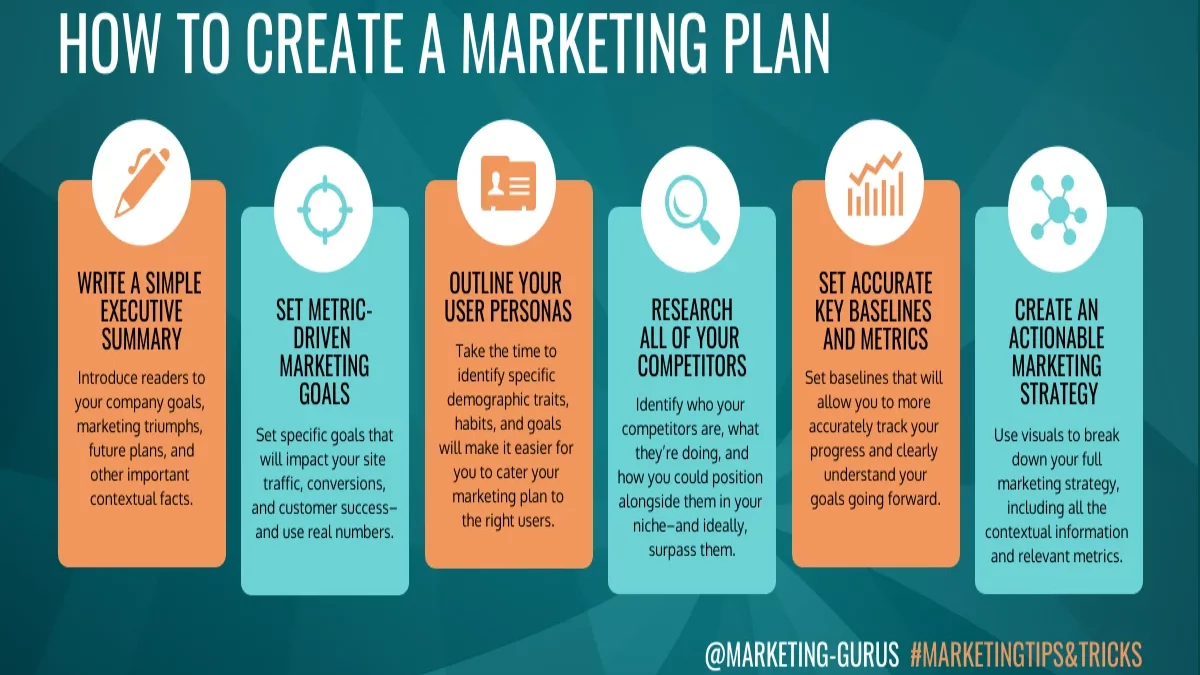A marketing plan is an organized and structured document that defines the business objectives achieved in a given period. The document details the strategies and actions that will be undertaken to achieve the goals within the foreseen period. It is integrated and forms part of the strategic plan of a company.
Table of Contents
Step 1: Analysis of the situation (external and internal)
The starting point is usually always an analysis of the current situation. The idea is that we have an analysis of the external and internal aspects of a company.
External aspects include competition, the primary market of interest, current customers, and buyer personas. The profiles of ideal clients (buyer personas) will be used later in many moments within the a marketing plan and the definition of tactics and their implementation.

Meanwhile, the internal aspects involve the structure of the company, its economic and human resources, objectives, etc.
It is, therefore, about determining where we are, what the scenario is, the history, and the business objectives.
To carry out this study, it is essential to prepare a SWOT, a survey that helps us discover:
- The strengths and weaknesses that we have internally are related to our organization, product, or services.
- The opportunities or threats that we have externally.
In analyzing opportunities and threats, we must bear in mind that these variables affect us and our competition since they are elements of the market.
The SWOT analysis is critical because it allows us to define the necessary strategies to take advantage of and maximize opportunities and minimize or eliminate threats.
Step 2: Definition of Objectives
Once the initial situation analysis has been carried out, we must define the objectives. This is a crucial step for our a marketing Plan strategy to be successful. It will depend on this definition that we can subsequently establish the strategy, tactics, and measurement elements that allow us to justify the investment made.
To correctly define objectives that help the success of our a marketing Plan strategy, these must be SMART:
- Specific (Specific): They must be concrete, without abstractions. For example, increase sales through an internet marketing action.
- Measurable (Measurable): They must be quantifiable so that we can measure their scope. If the objectives are not measurable, they will be purposes and wishes, not strategic objectives. Following the previous example, we would say “increase sales by 25% through an internet marketing action”.
- Achievable: They must be possible and likely, and, for this, it is essential to take the SWOT results as a basis. For example, if we are a recently created SME, we cannot establish a goal that seeks to lead the market for real estate sales on the Internet in just half a year.
- Relevant (Relevant): They must be appropriate to our business. In line with the previous point (achievable), we cannot establish objectives outside the general purposes of our business.
- Limited in time (Targeted and Time-Bound): We must establish the time the objective must be reached. Following the first example, we would say “increase sales by 25% through internet a marketing Plan activities within the next 12 months”.
Some examples of SMART goals are:
- I am invoicing 200,000 euros by 2020, adding digital marketing channels and internet sales.
- Position the brand on social networks through ads and campaigns in 6 months.
- Increase organic website visits by 15% per month for one year, doubling content production and distribution.
Step 3: Definition of Strategies
We must mark our strategy based on our objectives, which can also help us correct and enhance the data that we have extracted with our SWOT analysis.
Starting from our initial SWOT, we can develop a crossed SWOT that will help us establish strategies, starting with offensive ones, continuing with adaptive and survival ones, and ending with defensive ones.
- FO Strategies: We define our offensive strategy by taking advantage of opportunities and relying on strengths.
- DO Strategies: Given the inability to take advantage of an opportunity due to weakness, we establish our adaptive strategy.
- DA strategies are based on the existence of a threat that allows us to rely on a weakness; This is how we establish survival and conservation strategies.
- FA Strategies: Given the possibility of relying on a fortress to reduce the likelihood of a threat, we establish defensive strategies.
Step 4: Defining Tactics and Actions
Based on the established strategies, we must develop the tactics that we will carry out and the list of actions to be carried out to achieve the objectives.
There are different tactics that we can carry out, for example:
- RACE method: Reach (reach the audience); Act (influence the audience to make decisions); Convert (my potential customers buy); Engage (get retain and loyalty).
- Inbound marketing.
- Email marketing.
- Content marketing.
- Search Engine Marketing ( SEM ).
- Search Engine Optimization (SEO).
Within each tactic, we must establish a specific list of actions that we can later set on our calendar to confirm the order and time of their completion.
Step 5: Scheduling of Actions
As discussed in the previous point, once the tactics and actions have been define, it is essential to make decisions and put the list on the calendar. Again, placing each activity correctly in order and time will help us meet our objectives.
Also Read: About Technology
Step 6: Budget
Once the calendar has been establish, which includes the actions linked to the tactics and strategies that will allow us to reach our objectives, we must prepare the budget that shows the human and economic resources necessary to fulfill our a marketing Plan strategy.
Step 7: Control System
The control system is the last step in developing our a marketing plan. As we have commented in the definition of objectives, these must be measurable so that we can control their fulfillment.
Keeping this control during the implementation of our plan will allow us to detect failures and deviations and react in time to apply corrective measures that ensure the achievement of objectives and maximization of ROI. Therefore, we must establish control mechanisms for each purpose and partial achievement, not only for their scope at the end of the process.
Conclusion
This is a crucial step for our marketing Plan strategy to be successful. It will depend on this definition that we can subsequently establish the strategy, tactics, and measurement elements that allow us to justify the investment made. Thank you for reading. Suppose you have any questions or comments. You can share them below.

